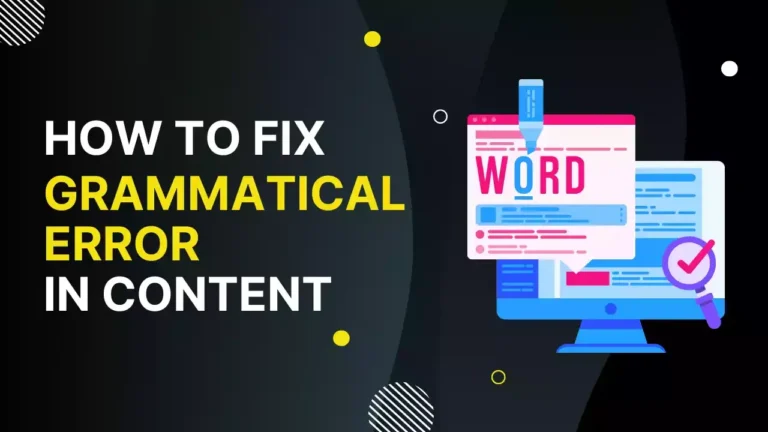The Best Way to Fix Plagiarized Content on Your Blog ( Simple Tricks)

Blogging is a great way for content marketers to expand the awareness and reach of a brand. It has gained so much traction in the last decade that traditional marketing has almost become obsolete.
The reasons for content marketing’s success are many, but the most important one is that it has considerably less investment required. You may have heard that it costs approximately 62% less than other types of marketing.
These low costs, paired with a relatively high return on investment (ROI) and long-term results, mean that content marketing is an effective marketing strategy.
Unfortunately, it can be hampered by one particular activity, and that is plagiarism.
What is Plagiarism? Why is it Important to Remove it?
Plagiarism is the act of using another person’s content and ideas without crediting them and passing them off as yours.
This is a terrible practice that, unfortunately, is quite rampant in the writing industry. With the power of the internet, it is very easy to commit plagiarism, but with the same power, it has become easy to detect it as well.
Search engines, in particular, are really good at detecting plagiarism. They punish the offenders by de-ranking their website or outright deleting the website’s entry from their index.
But search engines have one flaw; they cannot distinguish between intentional plagiarism and accidental plagiarism.
Accidental plagiarism is when writers unknowingly copy someone else. It can occur by a freak coincidence, or the writer unconsciously uses words they have read somewhere else. The point is that there is no malicious intent behind accidental plagiarism, but it is punished all the same; that’s why it is necessary to check your work for plagiarism.
Some Common Types of Plagiarism
How can one avoid or fix plagiarism if they do not know what it is? So, writers should know how plagiarism is committed so that they can avoid it. Plagiarism has many types, but it can be broadly categorized into four main ones.
1. Verbatim Plagiarism
In this type of plagiarism, the perpetrator copies content made by others word for word and uses it for their own website/blog. It is the most unapologetic form of plagiarism as the perpetrator is not even trying to hide their crime.
2. Accidental Plagiarism
This is a type of plagiarism that can occur unknowingly or mistakenly. If a person does not cite their sources properly or coincidentally writes the same thing as someone else, then that is called accidental plagiarism.
3. Mosaic Plagiarism
This is a nefarious sort of plagiarism and arguably the worst kind. The perpetrator takes bits and pieces of content from different sources and “patches” them together to make a new work. They also employ paraphrasing to make plagiarism harder to detect.
4. Self-Plagiarism
This is a type of plagiarism in which a person starts copying themselves. One would ask, why is it plagiarism if the person who wrote it is using it? That’s because search engines will only think of it as duplicate content. Also, in research, you are not allowed to take credit for a single work multiple times.
Best Way to Avoid and Remove Plagiarized Content
As the saying goes, “Prevention is better than cure” we should also try to avoid plagiarism in the first place rather than remove it after the article is done. For that matter, we are going to check out some tips on how to avoid and remove plagiarism from written works.
1. Extensive Research
The first step in avoiding plagiarism is to conduct in-depth research. All writing processes begin with research. Unless the author is an expert in their field, they need to collect information and data about their topic, learn most of the ins and outs of it then start writing.
If writers do not conduct enough research, they get affected by the opinions presented in their research material. They also only see the topic from a limited point of view. This results in accidental plagiarism as the writer unknowingly mimics the few sources they have read.
To avoid this pot-hole, writers need to conduct in-depth research. For example, if the topic you have to write about is “AR technology,” then you should read multiple articles on the advantages and good features of AR technology as well as its drawbacks and negatives. By reading and viewing the opposing viewpoints, writers get an unbiased and objective look at the topic.
With a large amount of information and an unbiased opinion, the written work will hopefully avoid plagiarism.
2. Citations and References
It is impossible for someone to write something on any topic that is completely new and unique. All new discoveries and innovations are made on the back of existing technology and information.
In writing, an author may have to use the ideas and findings of other authors to support their own arguments and claims. However, it is not okay to use the work of others without giving them their due credit, as it is considered plagiarism.
For that reason, citations and references are used. Now, depending on the institute or company that you write for, the format for citing and referencing will be different. So, make sure that you follow the correct format.
All citations need an entry in a reference list or bibliography at the end of a written work. For example, in the IEEE style, an in-text citation is simply a square bracket with a number in it. It looks like this: [1]. It is written at the end of the content that you are referencing.
This number refers to a complete entry in the bibliography. All entries in the bibliography are numbered, and the in-text citation refers to those numbers. So, a typical reference may look like this:
“…this idea was put forward in the year 19XX [1].”
And the complete entry would be something like this:
“[1] Author name/s, book name, publisher name, year of publishing”.
Of course, the styles of complete entries in the reference list differ depending on the source, so always check out how to correctly cite your sources in whichever style you are following.
3. Plan Your Approach
A shortcut to committing accidental plagiarism is to start writing without a plan. When writers do not have a clear direction, they tend to ramble around. To get an idea of where to go with their writing, they may unintentionally copy someone else.
This can be easily avoided if the writer makes a plan first. A common method of doing this is to create an outline for your article before writing it.
The outline should contain properly structured headings that follow what you want to write. For example, for this article, I created a simple outline that was as follows:
- Discuss plagiarism and its types
- Tips to avoid plagiarism
- Research
- Referencing
- Creating outlines
- Tracking sources
- Paraphrasing
- Plagiarism checking
- Conclusion
That is a very simple outline, but it serves to keep the writer on track and prevent rambling. Whenever a writer feels lost or doesn’t know what to write, looking at their outlines can help them out. This way, they don’t have to resort to copying others and avoid committing plagiarism.
4. Track Your Sources
Tracking sources is a great way to avoid plagiarism in your content. To understand why we shall look at how not tracking sources becomes the cause of accidental plagiarism.
When conducting extensive research, it is naturally difficult to keep in mind what ideas and information were taken from which source. This can result in a writer forgetting which ideas were taken from which source. They mistakenly assume that the idea was theirs, to begin with. Obviously, this is plagiarism.
That’s why it is important to keep a note of all the information and ideas and where they came from. A simple method to do so is to keep a diary or journal. When researching, note down any interesting ideas, facts, and figures from each source in that diary, along with the source’s name.
This way, you can consult that diary and always know which sources to cite or not cite. It is a simple, straightforward, and effective solution.
5. Take Advantage of Paraphrasing
Information that can be considered “public domain” or too general to be attributed to anyone can be used in your content without citations. However, search engines will still count it as duplicate content if the wording is the same as another source on the internet.
Hence, writers need to use paraphrasing techniques to remove that duplication. Paraphrasing is an important technique for all writers. It allows them to explain difficult concepts in easier words.
An example would be as follows:
“His knowledge of the matter transcended that of everyone in the room.”
This sentence can be paraphrased as follows:
“He had the most information about the topic than everyone else present.”
As you saw, a somewhat difficult sentence was rephrased to be much simpler and straightforward, making it different and unique in the process. This can also be done using a plagiarism fixer, which is a tool that can reword text to make it unique.
Do keep in mind that paraphrasing some content does not make it your property. So, if you are paraphrasing someone else’s content to use in your own work, you need to provide the proper citation and references.
6. Check for Plagiarism
Finally, when all is said and done, there is still a chance that you may have committed accidental plagiarism. It never hurts to double-check, so after you have written your first draft, you should check it for any duplication present.
The easiest way to do that is to get help from an online tool such as a plagiarism checker, which can detect plagiarism in written content. Tools are simply better at detecting plagiarism than human beings; they are faster, more accurate, and more reliable.
The neat part about utilizing a tool to check for plagiarism is that most of them provide detailed reports that show which parts of the text were duplicated and what was the source from which that information was “copied.”
To deal with plagiarism detected at such a late stage, there are two major ways.
- Either remove the duplicate content completely
- Or simply cite it so that plagiarism is no longer applicable.
The first method is useful when deleting the content does not distort the sense and meaning of the rest of it.
If the first method cannot be utilized, then simply citing the source correctly will be sufficient.
Conclusion
Fixing plagiarism in blogs requires that authors try to create plagiarism-free content in the first place. Once the content has been uploaded to the website, changing or removing it could have unintended effects on the SEO.
To avoid any future problems, it is better to check and remove plagiarism from the content before it is published. The tips discussed in this article are actionable and helpful in fixing plagiarism in their blog content.
Read Also: How to Send DMCA Takedown Notice and remove content from Google.





